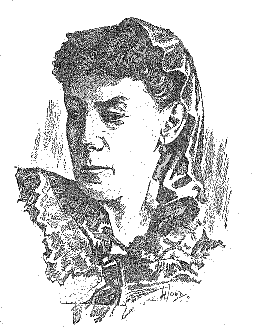
Amanda Douglas
Amanda Minnie Douglas was born on 14 July 1831 (some sources
erroneously list 1837) in New York City, the daughter of John and
Elizabeth Douglas. She attended the City Institute there, and,
after 1853 (when the family moved to Newark, New Jersey), continued
her education in English and American literature with a private
tutor. According to a contemporaneous biographical sketch,
"In childhood she was noted for her powers of story-telling,
when she would tell her friends long tales, regular serials,
that would continue for weeks." [1]
Douglas was planning to study engraving and design when family
illness intervened: she was eighteen at the time and her presence and
income were needed at home, so she took up writing, selling stories to various periodicals, including the Saturday Evening Post, New York Ledger, and Lady's Friend. As Douglas explained "I had no thought of becoming a novelist, as I was so interested in other pursuits; but the path seemed to open, and others proved quite impossible, as I could not leave my home." [2]
She remained in Newark, and apparently kept intellectually active,
joining "the Ray Palmer club--the oldest woman's literary organization
in the locality" and the New Jersey Women's Press Club. [3] She was acquainted with
several writers, including Edgar Allen Poe, and was friends with
Louisa May Alcott.
In addition to her writing, Douglas helped develop several inventions, and even patented
one: "a folding frame for a mosquito-net, to be used by travellers,
artists, and others." [4]
Douglas was a prolific writer; from
1866 to 1913, she usually published one or more books per year
and wrote for adults as well as children. In Trust, her first
book (an adult novel), was published in 1866, and its sales surpassed
20,000 copies. Unfortunately, Douglas had sold the copyright along
with the story and thus failed to benefit fully from its success.
Learning from her experience, she retained copyright on subsequent
books.
Her first girls' series, Kathie (1870-1871), was somewhat didactic and very much in the style of 19th-century series;
her next, "Little Girl" (e.g., A Little Girl in Old Boston,
A Little Girl in Old Philadelphia), was among the earliest historical fiction series
for girls. In 1893, she received a $2000 prize for the best work of juvenile fiction from Youth's Companion for a non-series title, Larry. More than ten years after her death, the entry in Dictionary of American Biography noted that "during her long life her books circulated widely and even to-day they are in constant demand in public and Sunday-school libraries."
Her biographical sketch in A Woman of the Century (1893) also noted "Douglas has suffered much from long illness, but she keeps up courage . . . She is a fluent talker and well informed on current events."[5]
Douglas never married. She died 18 July 1916 in Newark.
Notes
1. "Douglas, Miss Amanda Minnie." A Woman of the Century: Fourteen Hundred-Seventy Biographical Sketches Accompanied by Portraits of Leading American Women in All Walks of Life. Eds. Frances E. Willard and Mary A. Livermore. Charles Wells Moulton, 1893.
2. "Douglas, Amanda Minnie." Appleton's Cyclopaedia of American Biography. 1888. Rpt. Detroit: Gale Research, 1968. h
3. "Douglas, Amanda Minnie." Dictionary of American Biography. vol. 5. New York: Charles Scribner's Sons.
4. Appleton's Cyclopaedia.
5. Woman of the Century.
Additional sources consulted
American Woman Writers: A Critical Reference Guide from Colonial
Times to the Present. Ed. Lina Mainero. Vol. 1. New York: Ungar, 1979.
Girls' Series Books: 1840-1991. Children's Literature Research Collections. University
of Minnesota Libraries. 1992.
Liberty's Women.1980; Rpt. as Famous American Women. Ed. Robert McHenry. New York: Dover, 1983.
National Cyclopedia of American Biography. Vol. 2.
On to Douglas bibliography
Return to main page
Copyright 1999-2000 by Deidre Johnson
